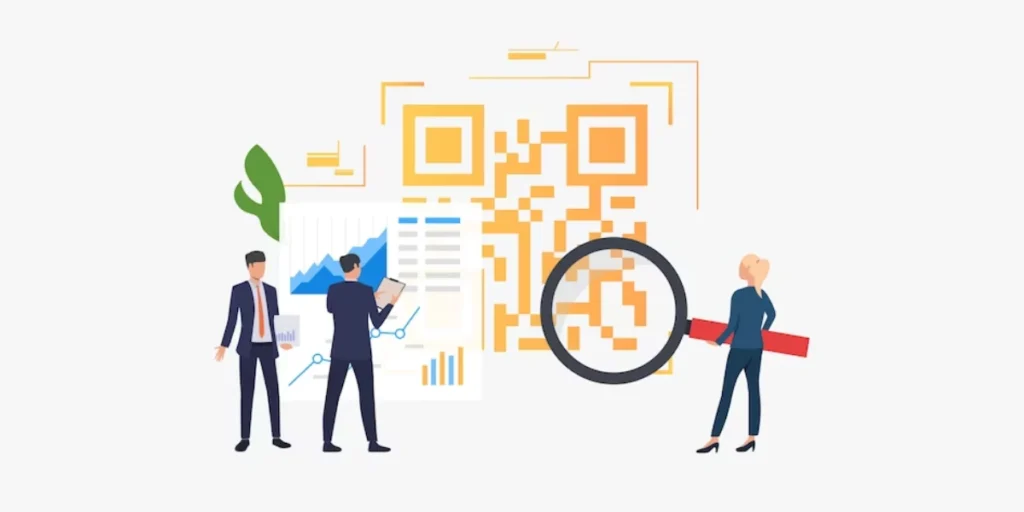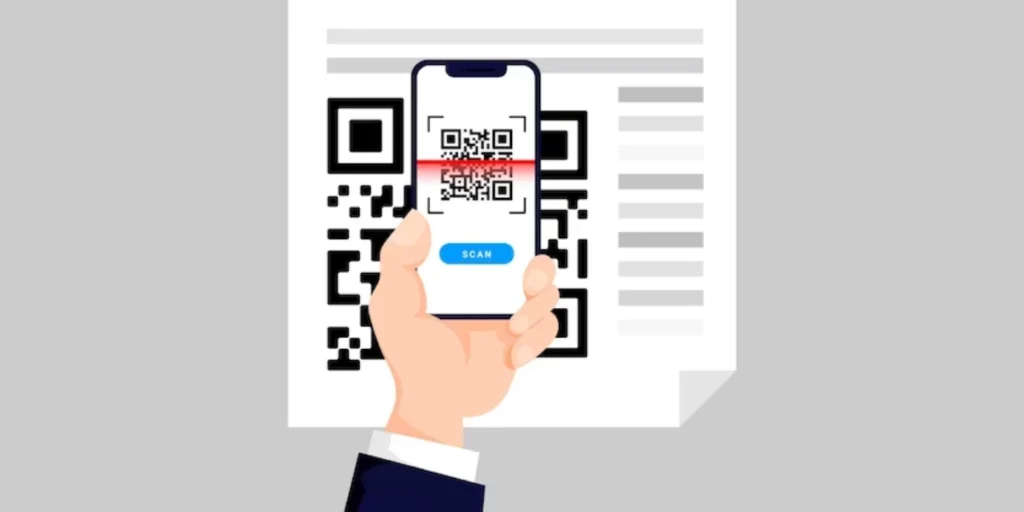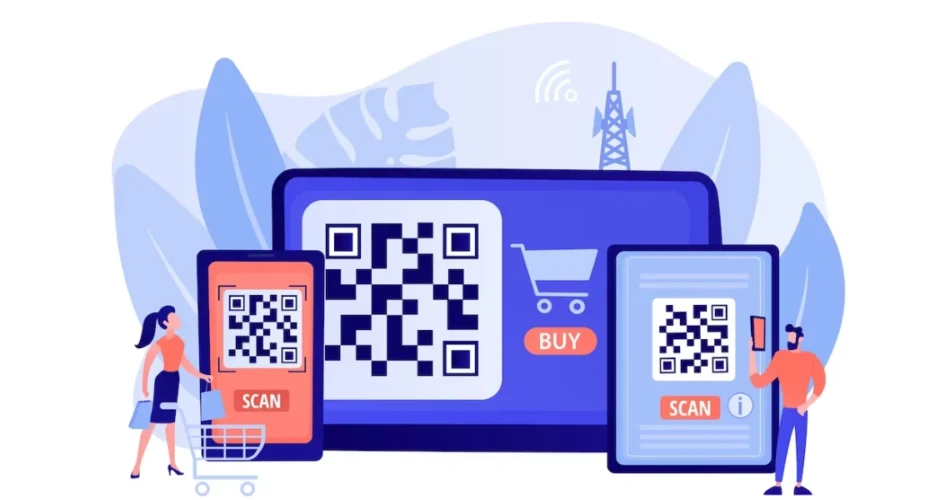Two-dimensional (2D) Codes, such as QR Codes and similar formats, have gained significant importance across various facets of our lives.
Their main attributes are their adaptability and user-friendly attributes. 2D Codes excel in information storage, surpassing traditional barCodes in capacity.
This versatility makes them valuable for encoding diverse data types. These could range from website links and contact details to intricate product information.
But have you wondered the difference between a data matrix and a QR Code?
To gain a clear understanding between the two, read further sections!
A. Data Matrix vs QR Codes: What makes them different

Data Matrix and QR Codes are two popular types of 2D bar Codes used for encoding and storing data in a compact, machine-readable format.
Both types of Codes serve similar purposes but have some differences in their structure and use cases:
1. Data Matrix
- Structure: Data Matrix Codes are square or rectangular in shape and consist of black and white square modules arranged in a grid pattern.
- Data Capacity: Data Matrix Codes can store a wide range of data types, including text, numbers, and binary data. The amount of data they can store depends on the size and version of the code but can go up to several kilobytes.
- Applications: Data Matrix Codes are commonly used in industrial and manufacturing settings. These could be for tasks like product tracking, inventory management, and quality control. They are also used in healthcare for labeling pharmaceuticals and medical devices.
2. QR Codes (Quick Response Codes)
- Structure: QR Codes are square-shaped and consist of black squares arranged on a white background, often with a square border and a unique pattern in the corners for orientation.
- Data Capacity: QR Codes have a high data capacity and can store various types of data, including alphanumeric characters, binary data, and special characters. Their data capacity ranges from a few dozen characters to several kilobytes, depending on the version and error correction level.
- Applications: QR Codes have many applications in marketing, advertising, and consumer interaction. They are used for tasks like linking to websites, sharing contact information (vCards), making mobile payments, providing Wi-Fi network access, and more. QR Codes are also used in ticketing, event management, and for accessing digital content quickly.
In short, Data Matrix Codes are prevalent in industrial applications while QR Codes are versatile and widely used in consumer scenarios.
B. Features of a data matrix

1. Compact size
Data matrix Codes are small and space-efficient, making them suitable for applications with limited real estate.
2. Matrix pattern
They are composed of black and white square modules arranged in a grid pattern, which facilitates easy scanning and decoding.
3. High data capacity
Data Matrix Codes can store a wide range of data types, including alphanumeric characters, binary data, and special characters. Their data capacity depends on the code’s size and version, ranging from a few characters to several kilobytes.
4. Error correction
They often include error correction capabilities, allowing for accurate data retrieval even when part of the code is damaged or obscured.
5. Machine-readable
Designed for machine-readable data capture, Data Matrix Codes are well-suited for automation and tracking purposes.
C. Use cases of a data matrix

Data Matrix Codes are widely used across various industries for a range of applications. This is mainly due to their compact size and high data capacity.
Here are some common use cases for Data Matrix Codes:
1. Manufacturing and supply chain management
Data Matrix Codes are applied to products, components, and packaging for product identification, tracking, and quality control. They help streamline manufacturing processes and ensure accurate inventory management.
2. Pharmaceuticals and healthcare
Data Matrix Codes are used on medication packaging to provide traceability, enabling healthcare professionals to verify authenticity and expiration dates. They are also used on medical devices for identification and tracking.
3. Aerospace and defense
In aerospace engineering, Data Matrix Codes are essential for part identification, maintenance tracking, and compliance with stringent traceability standards to ensure safety and reliability.
4. Electronics and electronics manufacturing
Data Matrix Codes are applied to electronic components, circuit boards, and devices for manufacturing and quality control. They aid in inventory management and product authentication.
5. Document management
Data Matrix Codes are used in document management systems to encode metadata about physical documents, making it easier to organize and retrieve documents in digital archives.
6. Shipping and logistics
They are printed on shipping labels and packages to facilitate efficient tracking and tracing of shipments, ensuring accurate delivery and real-time monitoring.
7. Automotive industry
Data Matrix Codes are used for part identification, quality control, and tracking throughout the automotive manufacturing process. They help ensure that the correct components are used in assembly.
8. Food industry
Data Matrix Codes are applied to food product packaging to provide information about the product, such as ingredients, nutritional facts, and expiration dates. They also support traceability and recall efforts in the event of food safety issues.
9. Retail and inventory management
In the retail sector, Data Matrix Codes are used for price labeling and inventory management. They help streamline stock management and pricing updates.
D. Features of a QR Code

1. Square shape
QR Codes are typically square in shape and consist of a grid of black squares on a white background. They may include a square border for easier detection.
2. High data capacity
QR Codes have a high data capacity, allowing them to store various types of data. These include alphanumeric characters, binary data, and special characters. The amount of data a QR Code can hold depends on its size and version. It could range from a few dozen characters to several kilobytes.
3. Error correction
QR Codes often include error correction capabilities. It means they can still be accurately decoded even if part of the code is damaged, obscured, or dirty. Error correction levels can be adjusted to suit the specific application.
4. Versatile data types
QR Codes can store a wide range of data types, including website URLs, contact information (vCards), Wi-Fi network credentials, text messages, and more. This versatility makes them suitable for various applications.
5. Machine-readable
QR Codes are designed for machine-readable data capture. They can be scanned and decoded quickly and accurately by mobile devices with built-in cameras or dedicated barcode scanners.
6. Customizable
QR Codes can be generated with different colors, patterns, and sizes. This is done to match the branding or design requirements of a specific application or campaign.
7. Security
QR Codes can include encrypted data to enhance security and prevent tampering. They are often used in secure authentication and verification processes.
8. Quick access
QR Codes allow for rapid access to information or actions. Users can scan a QR Code with a smartphone or tablet to perform tasks. It could be opening a website, making a payment, or accessing digital content.
9. Cost-effective
QR Codes are a cost-effective means of data encoding and retrieval. They can be easily generated and printed on various materials, including paper, labels, and digital screens.
10. Widely supported
QR Codes are supported by a wide range of devices and platforms, including smartphones, tablets, and desktop computers.
11. Trackable and analyzable
In marketing and advertising campaigns, QR Codes can be used to track user engagement. It can also collect data on how and when they are scanned. This allows for analytics and campaign optimization.
12. Environmentally friendly
QR Codes can reduce the need for printed materials, such as physical tickets or brochures, contributing to environmental sustainability.
E. Use cases of a QR Code

QR Codes (Quick Response Codes) have a wide range of practical use cases across various industries and applications.
Here are some common use cases of QR Codes:
1. Website URLs
QR Codes are often used to link to websites. Scanning the QR Code with a smartphone quickly opens the associated webpage.
2. Contact information
QR Codes can store contact information (vCards). Scanning the QR Code can automatically save the contact details to the user’s address book, simplifying networking and contact sharing.
3. Mobile payments
Payment apps like Apple Pay and Google Pay use QR Codes for secure and contactless transactions. Users scan a merchant’s QR Code to make payments.
4. Wi-Fi network access
QR Codes can store Wi-Fi network credentials. Scanning the code allows users to connect to a network without manually entering the SSID and password.
5. Event tickets
QR Codes are commonly used for electronic event tickets. Attendees can scan their QR Code tickets for entry to concerts, sporting events, conferences, and more.
6. Boarding passes
Airlines use QR Codes for mobile boarding passes. Passengers can scan their QR Codes at the airport for check-in and boarding.
7. Product packaging
QR Codes on product packaging can provide consumers with additional product information, user manuals, and promotional content when scanned.
8. Healthcare
QR Codes on medical records and prescriptions enhance efficiency and accuracy in healthcare settings. They can also be used for patient identification and appointment scheduling.
9. Inventory and Asset Management
QR Codes are used in businesses to track inventory and manage assets. Each item or asset is assigned a unique QR Code for easy identification and tracking.
10. Marketing and advertising campaigns
QR Codes are integrated into marketing materials such as posters, flyers, and brochures. Scanning the QR Code can lead to product pages, promotional videos, or discounts.
11. Restaurant menus
In the era of digital menus, QR Codes are often placed on restaurant tables. Customers scan the code to access the menu on their smartphones.
12. Educational materials
QR Codes in educational materials provide links to supplementary online resources and more.
13. Public transport
QR Codes are used for electronic ticketing on buses, trains, and subways. Passengers scan the code for fare payment and access.
14. Authentication and security
QR Codes with encrypted data are used for secure authentication and access control in corporate environments, buildings, and events.
15. Emergency information
QR Codes on personal items can store emergency contact information. These details are useful in case of accidents or medical emergencies.
16. Loyalty programs
QR Codes are used to track and reward customer loyalty. Scanning the code can earn customers points, discounts, or special offers.
17. Art and exhibitions
QR Codes in museums and art galleries provide additional information about exhibits, artists, and historical context.
Generate a QR Code For Your Unique Case
START TODAY!
F. Scanning a data matrix code

Scanning Data Matrix codes involves using a device or software equipped with a camera or barcode scanner capable of reading 2D barcodes.
Here are the general steps to scan a Data Matrix code:
1. Prepare your device
Ensure that you have a device with a camera or a dedicated barcode scanner capable of reading Data Matrix codes. This can be a smartphone, tablet, barcode scanner, or webcam-equipped computer.
2. Install a QR Code/barcode scanner app
On a smartphone or tablet, you may need to download and install a QR Code or barcode scanning app from your device’s app store. Many devices come with a pre-installed scanning feature in the camera app.
3. Open the scanning app
Launch the scanning app on your device. If your device’s camera app supports barcode scanning, open the camera app.
4. Position the code
Hold your device’s camera or scanner in front of the Data Matrix code. Ensure that the code is well-lit and within the camera’s field of view. Hold the device steady.
5. Focus and scan
In most cases, the scanning app or camera app will automatically focus on the code. If not, tap the screen to focus manually. Once the code is in focus, the app or camera will attempt to scan it.
6. Wait for confirmation
When the scanning process is successful, the app or camera will typically provide an audible beep or visual notification, and the decoded data from the Data Matrix code will be displayed on your device’s screen.
7. Interpret the data
The decoded data may vary depending on the content of the Data Matrix code. It could be a URL, text, numerical code, or other information. The scanning app may also perform specific actions based on the code’s content (e.g., open a website or save contact information).
8. Take action
Depending on the content and purpose of the scanned Data Matrix code, you can take appropriate actions. For example, if it’s a web link, your device may prompt you to open a web browser and visit the linked website.
9. Save or share the data
In some cases, you may want to save or share the scanned data. Scanning apps often offer options to save contact information, bookmark websites, or share content through various means.
10. Close the scanning app
After you have completed the desired actions or saved the data, you can close the scanning app or camera.
G. Scanning a QR Code

Scanning a QR Code is a fairly easy process when it comes to data matrix vs. QR Codes.
To know everything about it, click here!
Reading not your thing?
You can even watch a video to learn about scanning a QR Code.
H. Factors to consider while choosing: Data matrix vs. QR Codes

When choosing a 2D code for a specific application, several factors should be taken into consideration.
This will ensure that the code meets your requirements and effectively serves its purpose.
Here are key factors to consider when selecting a 2D code:
1. Data capacity
Determine the amount of data you need to encode within the code. Different 2D codes have varying data capacities. Choose a code that can accommodate your data without becoming too complex or large.
2. Scanning distance and size
Consider the scanning equipment and distance at which the code will be scanned. Some codes are designed for close-range scanning, while others can be scanned from a distance. Ensure compatibility with your scanning devices.
3. Error correction
Evaluate the level of error correction needed. Some applications require high error correction to ensure accurate data retrieval, especially if the code may be damaged or obscured during scanning.
4. Size and placement constraints
Take into account the available space for code placement. Ensure that the selected code can fit within the designated area without compromising readability.
5. Printing and material
Consider the materials on which the code will be printed. Different codes may require specific printing methods or may work better on certain surfaces. Ensure the selected code is suitable for the printing materials and environment.
6. Scanning equipment
Verify that the scanning equipment supports the chosen 2D code format. Compatibility with your scanning devices is crucial for successful implementation.
7. Readability and scanning speed
Evaluate the readability and scanning speed of the code. Some codes may be easier and quicker to scan than others, which can impact efficiency in high-throughput environments.
8. Application specifics
Consider the specific application and industry requirements. Certain industries, such as healthcare or aerospace, may have standards or regulations that dictate the use of specific 2D codes.
9. Security and data protection
Assess the security needs of your application. Some 2D codes offer features like encryption or digital signatures to enhance data security and prevent tampering.
10. Durability and environmental conditions
Evaluate the durability of the code and its ability to withstand environmental factors such as moisture, heat, and UV exposure.
11. Cost and budget
Consider the cost of generating and implementing the chosen 2D code. Some codes may require specialized software or equipment, which could impact your budget.
12. Compatibility with data processing systems
Ensure that the data encoded in the 2D code can be easily processed and integrated into your data management or inventory systems.
13. Future scalability
Think about whether the chosen 2D code will accommodate future needs or changes in data requirements. Choosing a code with room for growth can save you from having to transition to a different code later.
14. Industry standards
Check if there are industry-specific standards or recommendations for 2D codes in your field. Adhering to these standards can ensure compatibility and compliance.
15. Usability for end users
Consider the ease of use for end users who will be scanning the code. Ensure that it doesn’t require complex equipment or software for them to access the encoded information.
I. Future trends: Data matrix vs. QR Codes

1. Enhanced security features
To prevent counterfeiting and fraud, 2D codes may incorporate advanced security features, such as encryption and digital signatures, making them more secure for transactions and data sharing.
2. Augmented reality integration
Combining 2D codes with augmented reality (AR) can create interactive experiences. Scanning a code might trigger 3D animations, videos, or additional information, adding a new dimension to marketing and product packaging.
3. IoT connectivity
With the growth of the Internet of Things (IoT), 2D codes could serve as a means of connecting physical objects to the digital world. For example, products could have QR Codes that provide real-time information about their usage or maintenance.These codes could link to IoT cloud platforms that gather and analyze sensor data from connected devices. As IoT devices connect to the cloud for data gathering and analysis, a cloud workload protection platform (CWPP) can help secure the workloads, ensuring secure authentication, monitoring for anomalies, and facilitating encryption measures within the context of QR code-linked IoT platforms.
4. Healthcare and medical applications
2D codes may play a more significant role in healthcare for patient identification, medication tracking, and access to electronic health records, enhancing patient safety and care.
5. Environmental and sustainability initiatives
QR Codes on products could provide consumers with detailed information about the product’s environmental impact, recycling instructions, and the carbon footprint of its production.
6. Personalization and customization
2D codes may be used for highly personalized marketing campaigns, with codes tailored to individual preferences and behaviors, making marketing efforts more effective.
7. Payment and wallet integration
The use of QR Codes for mobile payments, similar to what is prevalent in countries like China (e.g., WeChat Pay and Alipay), could expand globally, simplifying payment processes.
8. Blockchain integration
2D codes may be used to facilitate blockchain-based tracking and provenance for products, ensuring transparency and authenticity in supply chains.
9. Multilingual and universal codes
There could be efforts to create standardized, multilingual 2D codes that work globally, making it easier for international travelers and businesses.
10. Accessibility features
Integration with accessibility tools for visually impaired individuals could become more prevalent, making it easier for everyone to access information from 2D codes.
11. Biometric scanning
In the realm of security, 2D codes may be integrated with biometric authentication methods, such as facial recognition, for secure access to sensitive information.
Generate a QR Code For Your Unique Case
START TODAY!
J. FAQs: Data matrix vs. QR Codes

1. What are Data Matrix codes and QR Codes, and how do they differ?
Data Matrix Codes: Data Matrix codes are 2D matrix barcodes that consist of black squares arranged on a white background. They are typically smaller and denser than QR Codes. Data Matrix codes are used for encoding small amounts of data, such as serial numbers, and are commonly used in manufacturing and logistics for product tracking.
QR Codes: QR Codes, short for Quick Response codes, are also 2D matrix barcodes but have a larger and more recognizable square pattern. They are designed to store various types of information, including text, URLs, contact information, and more. QR Codes are widely used for marketing, mobile payments, and various applications due to their versatility.
2. When should I use Data Matrix codes, and when should I use QR Codes?
Data Matrix Codes: Use Data Matrix codes when you need to encode a small amount of data, and space is limited. They are suitable for applications like product labeling, inventory tracking, and manufacturing processes.
QR Codes: Use QR Codes when you want to encode a variety of data types, including URLs, text, contact information, or Wi-Fi credentials. QR Codes are versatile and can be used in marketing materials, mobile apps, educational materials, and more.
3. Which code is more suitable for mobile marketing and promotions?
QR Codes are the preferred choice for mobile marketing and promotions due to their ability to store URLs, enabling users to access websites, landing pages, and multimedia content by scanning the code with a mobile device. They are commonly used for advertising campaigns, product packaging, and event promotions.
4. Can Data Matrix codes be scanned by regular smartphone cameras?
Yes, but with limitations: While some smartphone cameras can scan Data Matrix codes, it’s less common compared to QR Codes. QR Code scanning is a standard feature in many mobile devices and apps, making QR Codes more accessible to a wider audience.
5. Are there specific industries that favor one code over the other?
Data Matrix Codes: Data Matrix codes are often favored in industries like manufacturing, automotive, and healthcare for purposes like parts tracking, inventory management, and medical device identification.
QR Codes: QR Codes are used in a wide range of industries, including retail, marketing, tourism, and healthcare, for purposes such as advertising, product packaging, ticketing, and patient information access.
6. Which code provides better error correction and data recovery capabilities?
QR Codes generally offer better error correction and data recovery capabilities. They can handle damage or smudging of the code and still provide accurate data, making them more robust in real-world conditions.
7. Can either code store encrypted or secure data?
Both can store encrypted data: Both Data Matrix codes and QR Codes can store encrypted data, but the level of security depends on the encryption and decryption mechanisms used with the encoded data. QR Codes are more commonly used for secure mobile payment applications.
Summing Up
In the world of 2D barcodes, Data Matrix and QR Codes each bring their own unique strengths and applications to the table.
Whether you’re a business owner, a marketer, or simply someone curious about the world of barcode technology, understanding the differences between these two is essential.
If you’re still reading, you’ve already learned everything about data matrix vs. QR Codes. If you have any questions, let us know in the comments.
